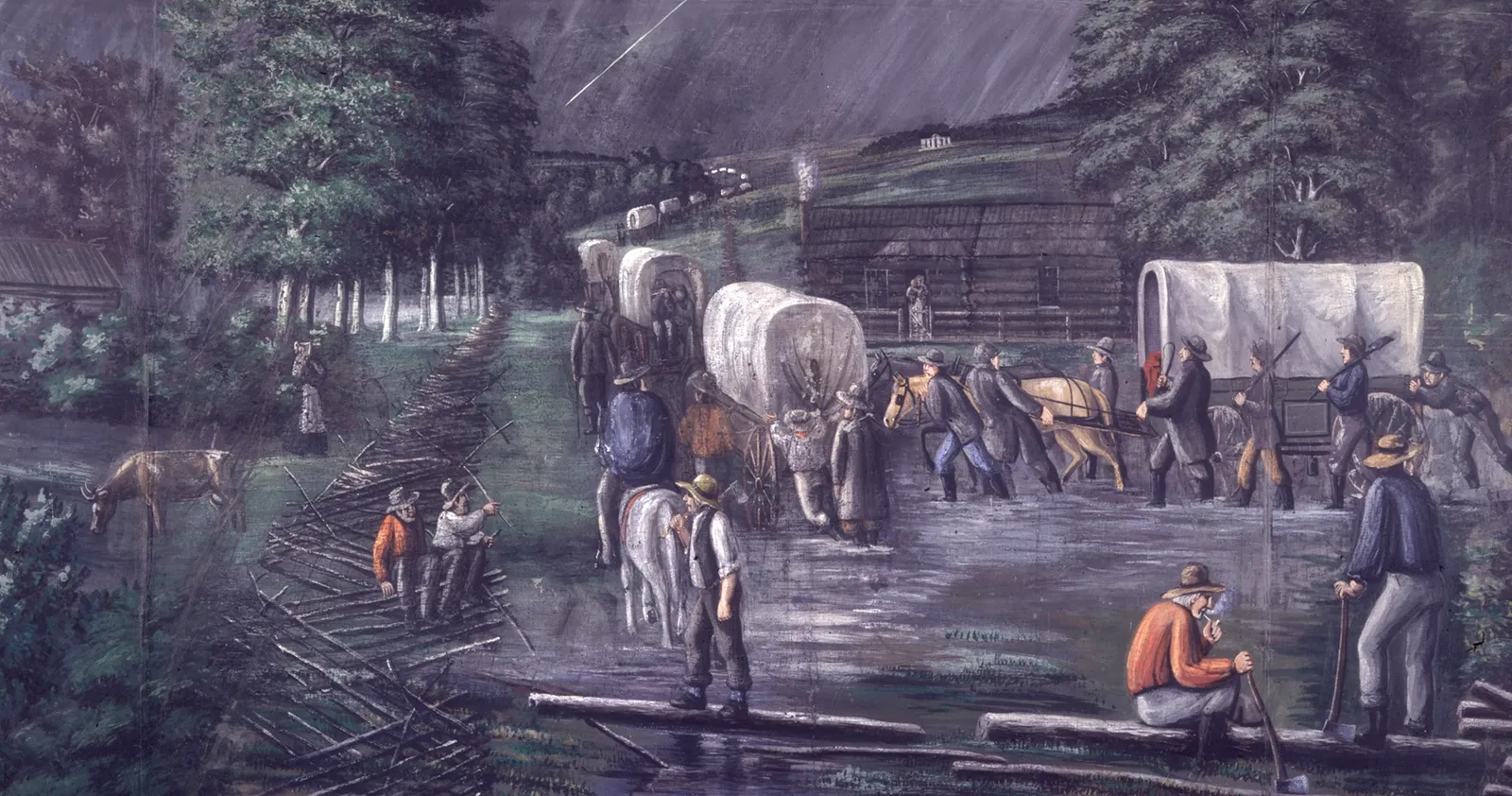Come, Follow Me Doctrine and Covenants
Doctrine and Covenants 102–105
C.C.A. Christensen (1831–1912), Zion’s Camp, c. 1878, tempera on muslin, 78 x 114 inches. Brigham Young University Museum of Art, gift of the grandchildren of C.C.A. Christensen, 1970.

The Saints in Kirtland were heartbroken to hear that their brothers and sisters in Jackson County, Missouri, were being driven from their homes. It must have been encouraging, then, when the Lord declared that “the redemption of Zion” would “come by power” (Doctrine and Covenants 103:15). With that promise in their hearts, over 200 men and about 25 women and children enlisted in what they called the Camp of Israel, later known as Zion’s Camp. Its mission was to march to Missouri and redeem Zion.
To the members of the camp, redeeming Zion meant restoring the Saints to their land. But just before they arrived in Jackson County, the Lord told Joseph Smith to disband Zion’s Camp. Some members of the camp were confused and upset; it seemed the expedition had failed and the Lord’s promises were not fulfilled. Others, however, saw it differently. While the exiled Saints did not get their lands and homes back, the experience did bring a degree of “redemption” to Zion, and it did “come by power.” Faithful members of Zion’s Camp, many of whom later became leaders of the Church, testified that the experience deepened their faith in God’s power, in Joseph Smith’s divine call, and in Zion—not just Zion the place but Zion the people of God. Rather than questioning the value of this seemingly unsuccessful task, they learned that the real task is to follow the Savior, even when we don’t understand everything. This is how Zion, ultimately, will be redeemed.
D&C 102: Minutes of the organization of the first high council of the Church, at Kirtland, Ohio, February 17, 1834. The original minutes were recorded by Elders Oliver Cowdery and Orson Hyde. The Prophet revised the minutes the following day, and the next day the corrected minutes were unanimously accepted by the high council as “a form and constitution of the high council” of the Church. Verses 30 through 32, having to do with the Council of the Twelve Apostles, were added in 1835 under Joseph Smith’s direction when this section was prepared for publication in the Doctrine and Covenants.
D&C 103: Revelation given through Joseph Smith the Prophet, at Kirtland, Ohio, February 24, 1834. This revelation was received after the arrival in Kirtland, Ohio, of Parley P. Pratt and Lyman Wight, who had come from Missouri to counsel with the Prophet as to the relief and restoration of the Saints to their lands in Jackson County.
D&C 104: Revelation given to Joseph Smith the Prophet, at or near Kirtland, Ohio, April 23, 1834, concerning the United Firm (see the headings to sections 78 and 82). The occasion was likely that of a council meeting of members of the United Firm, which discussed the pressing temporal needs of the Church. An earlier meeting of the firm on April 10 had resolved that the organization be dissolved. This revelation directs that the firm instead be reorganized; its properties were to be divided among members of the firm as their stewardships. Under Joseph Smith’s direction, the phrase “United Firm” was later replaced with “United Order” in the revelation.
D&C 105: Revelation given through Joseph Smith the Prophet, on Fishing River, Missouri, June 22, 1834. Under the leadership of the Prophet, Saints from Ohio and other areas marched to Missouri in an expedition later known as Zion’s Camp. Their purpose was to escort the expelled Missouri Saints back to their lands in Jackson County. Missourians who had previously persecuted the Saints feared retaliation from Zion’s Camp and preemptively attacked some Saints living in Clay County, Missouri. After the Missouri governor withdrew his promise to support the Saints, Joseph Smith received this revelation.
- Come, Follow Me Study and Teaching Helps — Lesson 38: D&C 102–105 (2021), Jonn Claybaugh
 Audio Roundtable: Come, Follow Me Doctrine and Covenants Lesson 38 (D&C 102–105) (2021)
Audio Roundtable: Come, Follow Me Doctrine and Covenants Lesson 38 (D&C 102–105) (2021)
 Nibley Lectures: Come, Follow Me D&C Lesson 38
Nibley Lectures: Come, Follow Me D&C Lesson 38
 Scripture Roundtable: D&C Gospel Doctrine Lesson 14, "The Law of Consecration", Administration, March 20, 2017
Scripture Roundtable: D&C Gospel Doctrine Lesson 14, "The Law of Consecration", Administration, March 20, 2017
 Scripture Roundtable: D&C Gospel Doctrine Lesson 27, "They Must Needs Be Chastened and Tried, Even as Abraham", Administration, June 16, 2017
Scripture Roundtable: D&C Gospel Doctrine Lesson 27, "They Must Needs Be Chastened and Tried, Even as Abraham", Administration, June 16, 2017
 Scripture Roundtable: D&C Gospel Doctrine Lesson 38, "In Mine Own Way", Administration, August 2, 2017
Scripture Roundtable: D&C Gospel Doctrine Lesson 38, "In Mine Own Way", Administration, August 2, 2017
 Scripture Roundtable: D&C Gospel Doctrine Lesson 46, "Zion—The Pure in Heart", Administration, October 30, 2013
Scripture Roundtable: D&C Gospel Doctrine Lesson 46, "Zion—The Pure in Heart", Administration, October 30, 2013
- Come, Follow Me—For Home and Church: Doctrine and Covenants 2025
- Voices of the Restoration: Zion’s Camp
- Waiting for the Word of the Lord, Revelations in Context
 Disciplinary Councils, Doctrine and Covenants Teaching Videos, President Gordon B. Hinckley
Disciplinary Councils, Doctrine and Covenants Teaching Videos, President Gordon B. Hinckley
 The Church is Governed through Councils, Doctrine and Covenants Teaching Videos, Elder M. Russell Ballard
The Church is Governed through Councils, Doctrine and Covenants Teaching Videos, Elder M. Russell Ballard
- Restoring the Ancient Order, Revelations in Context
- Chapter 40: Doctrine and Covenants 102; 104, Doctrine and Covenants Institute Student Manual (2017)
- The Acceptable Offering of Zion’s Camp, Revelations in Context
 Pay Off Debts as Quickly as You Can, Doctrine and Covenants Teaching Videos, President Gordon B. Hinckley
Pay Off Debts as Quickly as You Can, Doctrine and Covenants Teaching Videos, President Gordon B. Hinckley
- Newel K. Whitney and the United Firm, Revelations in Context
- Chapter 41: Doctrine and Covenants 103; 105, Doctrine and Covenants Institute Student Manual (2017)
 Zion’s Camp, Doctrine and Covenants Teaching Videos
Zion’s Camp, Doctrine and Covenants Teaching Videos
- Zion’s Camp—Preparing to Serve the Lord – Doctrine and Covenants 102–105, Liahona – Come, Follow Me: Doctrine and Covenants
- Section 102, Harper, Steven C. – D&C Contexts (Book of Mormon Central Archive)
- Section 103, Harper, Steven C. – D&C Contexts (Book of Mormon Central Archive)
- Section 104, Harper, Steven C. – D&C Contexts (Book of Mormon Central Archive)
- Section 105, Harper, Steven C. – D&C Contexts (Book of Mormon Central Archive)
- Why Did Joseph Smith File for Bankruptcy?, Book of Mormon Central KnoWhy #622
- Doctrine & Covenants 102, Doctrine & Covenants Central
- Doctrine & Covenants 103, Doctrine & Covenants Central
- Doctrine & Covenants 104, Doctrine & Covenants Central
- Doctrine & Covenants 105, Doctrine & Covenants Central
- Doctrine and Covenants 102 to 105 – “After Much Tribulation … Cometh the Blessing”, BYU Studies
 BYU Religious Education Discussions on the Doctrine and Covenants: Inasmuch as They Are Faithful D&C 102, 104, 106
BYU Religious Education Discussions on the Doctrine and Covenants: Inasmuch as They Are Faithful D&C 102, 104, 106
 BYU Religious Education Discussions on the Doctrine and Covenants: Chastened and Tried D&C 101, 103, 105
BYU Religious Education Discussions on the Doctrine and Covenants: Chastened and Tried D&C 101, 103, 105


